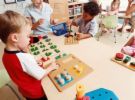Child Development and Learning Care Notes
"Kindess in giving creates love." - Lao Tzu
- Mind and heart, learning and loving, together – a child’s spirit grows.
- Cherish what you’ve learned; embrace what you are learning; create opportunities to learn more.
- Development involves influences of both nature and nurture.
- The brain grows at an amazing rate during early childhood development.
- “Exercising” the brain daily makes new connections and increases in intelligence.
- Learning and relearning can take place at any age
- Early age development, a time of surplus of brain connections, dramatically influences the rest of our lives.
- Learning necessitates the working relationship of multiple brain areas.
- Learning involves functions of attention, speech, language
 , memory, executive function, sensory, motor and mood.
, memory, executive function, sensory, motor and mood. - In all cultures, the brain and environment work together to develop a child's potential.
- Early intervention and prevention reflects wisdom.
- Families and communities play a vital role in learning and brain development.
- Teaching must embrace both mind and heart.
- It is important to teach empathy, caring and respect of others, as well as reading, writing and arithmetic.
- Sensations begin development in utero.
- Stress affects brain development and learning.
- Optimal learning requires relaxed alertness.
- Positive self-esteem increases development of self.
- Relate to your Child in a multisensory fashion. Every sound touch, sight, taste, smell, makes a brain behavior connection.
- Positive multisensory influences increase intelligence.

- The brain has had hundred millions of years to form into what it is today.
- We can see the brain development in utero at 3 weeks after conception when the embryo is only approximately 3 mm long.
- The average brain weighs approximately 3 pounds.
- The brain consists of millions of cells each connecting with tens of thousands of others through electrical-chemical impulses resulting in trillions of connections.
- Brain connections allow us to learn, adapt to the environment, and control the workings of our bodies.
- Brain connections decrease after the first few years of life, although the brain continues to respond to experience and develops connections throughout life.
- Increased knowledge of brain development dramatically influences family life, education, and public policy.
- Acquired illness, trauma, neglect, substance abuse, environmental toxins, poverty, etc., can all impede brain development and learning.
- As children we learn by repetition and recollection. As we grow, we learn by reflection-active thinking.
- External speech becomes internal speech, which guides our behaviors and learning.
- Learning of mind and heart develops healthy people.

- There are multiple kinds of minds and multiple learning styles.
- Healthy nutrition is necessary for healthy development. Food sensitivities can affect learning.
- We are all born to win.
- Movement is our first language.
- In early childhood sensory systems integrate so as to influence further learning.
- Emotional well being affects global well being and health.
- The brain is the only organ in the human system that learns.
- Children are not lazy: if a child has difficulty with a task, ask if the child has the necessary ability to do the task.
- Learning is a major health issue.
